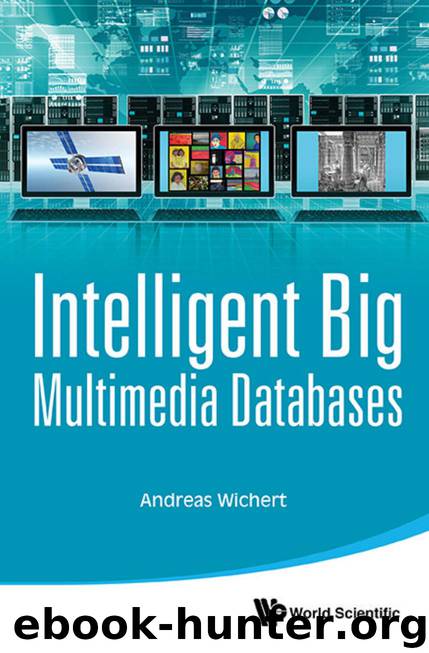Intelligent Big Multimedia Databases by Andreas Wichert

Author:Andreas Wichert [Wichert, Andreas]
Language: eng
Format: epub
Published: 2015-06-06T16:59:44+00:00
April 7, 2015 16:32
ws-book9x6
9665-main page 153
Low Dimensional Indexing
153
a lower bound and an upper bound, which is the distance from the query
point to the centroid minus the radius for the lower bound plus the radius
for the upper bound value. According to Böhm, SS-trees outperform the
R-trees [Böhm et al. (2001)].
Numerous tree structures, such as SR-trees, which can be regarded as
a variation of the R-tree, such as the SS-tree, R∗-trees, X-trees, TV-trees
use different heuristics to minimize or prevent overlap of the main regions
(for example MBRs).
6.3.4
High-dimensional space
Traditional tree-based methods employ the principle of hierarchical clus-
tering of the data space, in which metric properties are used to construct a
tree that can be used to prune branches while processing the queries. The
performance of tree-based methods deteriorates with large dimensionality.
To understand why these methods fail in high-dimensional spaces, let us as-
sume that our tree has only the hierarchy space. We group the images into
clusters represented by the cluster centers cj. After clustering, k centroids
c1, c2 · · · , ck
and k clusters
C1, C2 · · · , Ck
are present with
Cj = {x|d2(x, cj) = min d2(x, ct)}.
(6.21)
t
Each cluster Cj contains the points that are closest to the centroid cj.
During the categorization task of a given query vector y, the most similar
centroid ci is determined representing the group of similar vectors. Does
this simple model also work for query retrieval? Could we take advantage of
the grouping of the vectors into clusters? The idea would be to determine
the most similar centroid ci which represents the most similar category.
In the next step, we would search for the most similar vector according
to the -similarity only in this cluster Ci. By doing so, we could save
some considerable computation, see Figure 6.16. Suppose l = mini d(y, ci)
is the distance to the closest centroid and rmax is the maximal radius of
all the clusters. Only if l ≥ ≥ rmax, we are guaranteed to determine
similar vectors. Otherwise we have to analyze other clusters as well, Figures
6.17, 6.18 and Figure 6.19 indicate some counter examples for other cases
Download
This site does not store any files on its server. We only index and link to content provided by other sites. Please contact the content providers to delete copyright contents if any and email us, we'll remove relevant links or contents immediately.
| Computer Vision & Pattern Recognition | Expert Systems |
| Intelligence & Semantics | Machine Theory |
| Natural Language Processing | Neural Networks |
Algorithms of the Intelligent Web by Haralambos Marmanis;Dmitry Babenko(16232)
Jquery UI in Action : Master the concepts Of Jquery UI: A Step By Step Approach by ANMOL GOYAL(9385)
Test-Driven Development with Java by Alan Mellor(7729)
Data Augmentation with Python by Duc Haba(7606)
Principles of Data Fabric by Sonia Mezzetta(7376)
Learn Blender Simulations the Right Way by Stephen Pearson(7294)
Microservices with Spring Boot 3 and Spring Cloud by Magnus Larsson(7137)
Hadoop in Practice by Alex Holmes(6587)
RPA Solution Architect's Handbook by Sachin Sahgal(6513)
The Infinite Retina by Robert Scoble Irena Cronin(6215)
Big Data Analysis with Python by Ivan Marin(5930)
Life 3.0: Being Human in the Age of Artificial Intelligence by Tegmark Max(5506)
Pretrain Vision and Large Language Models in Python by Emily Webber(4893)
Infrastructure as Code for Beginners by Russ McKendrick(4651)
Functional Programming in JavaScript by Mantyla Dan(4434)
WordPress Plugin Development Cookbook by Yannick Lefebvre(4379)
The Age of Surveillance Capitalism by Shoshana Zuboff(4241)
Embracing Microservices Design by Ovais Mehboob Ahmed Khan Nabil Siddiqui and Timothy Oleson(4146)
Applied Machine Learning for Healthcare and Life Sciences Using AWS by Ujjwal Ratan(4134)
